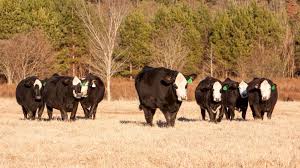Mark Z. Johnson, Oklahoma State University
The increasing mature weight of beef cows is concerning. Larger cows have higher nutrient requirements. Improving the efficiency, sustainability and profit potential of commercial cow calf production involves reducing feed costs while improving pounds of calf weaned. Reducing the mature weight of beef cows has a favorable impact on feed costs. Cumulative weight weaned throughout a cow’s life in production is the result of total pounds of calves weaned and will be higher for cows that annually calve earlier, wean a healthy calf, and avoid being culled as a result of reproductive failure, unsoundness and bad disposition.
The Role of Selection and Mating
Mature cow size can be effectively controlled through sire selection. Mature cow weight is a high heritability trait with literature estimates ranging from 35 to 70%. Selection pressure applied to Mature Weight Expected Progeny Differences (EPDs) in sire selection should be an effective means of changing mature weight.
Fertility is low in heritability with estimates ranging from 0 to 15%. Selection pressure, based on additive genetic merit alone, results in very slow progress in improving fertility. Fertility is more largely influenced by nutritional environment and non-additive genetic merit. Non-additive genetic merit (or gene combination value) is the result of mating decisions. The mating decision to crossbreed generates hybrid vigor. Considerable research has clearly demonstrated the potential for increasing beef cow productivity through crossbreeding. Accumulated experimental data indicates pounds of calf weaned per cow can be increased by as much as 25% in well designed, systematic crossbreeding programs involving Hereford, Angus and Shorthorn. Approximately half of this increase in total production is dependent upon use of the crossbred cow to take advantage of heterosis for fertility, reproductive fitness, longevity and maternal performance.
Crossbreeding provides the commercial producer the opportunity to increase the cumulative weight weaned throughout a cow’s lifetime in production. Selection pressure should be applied based on the additive genetic merit (EPDs) of traits of primary economic importance.
Bottom Line
Improving mature cow size and productivity can be accomplished in tandem through selection and mating decisions. Sire selection can be an effective means to reduce the mature size of a cowherd. Total pounds of calf weaned during the productive lifetime of a cow can be improved by a well-planned crossbreeding system.














